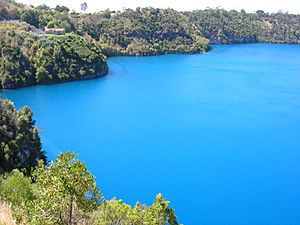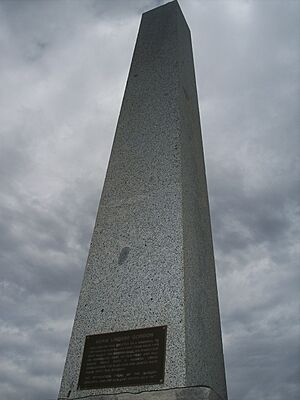Blue Lake (South Australia) facts for kids
Quick facts for kids Blue Lake |
|
|---|---|

Blue Lake
|
|
| Location | Mount Gambier, South Australia |
| Coordinates | 37°50′48″S 140°46′41″E / 37.84667°S 140.77806°E |
| Type | Crater lake |
| Catchment area | Blue Lake Catchment Area |
| Basin countries | Australia |
| Max. length | 1,087 m (3,566 ft) |
| Max. width | 657 m (2,156 ft) |
| Surface area | 70 ha (170 acres) |
| Average depth | 72 m (236 ft) |
| Max. depth | 77 m |
| Shore length1 | None |
| Islands | None |
| Settlements | None |
| 1 Shore length is not a well-defined measure. | |
The Blue Lake is a special lake found in Mount Gambier, South Australia. It sits inside an extinct volcano crater. This crater is part of the larger Mount Gambier volcanic area. The Blue Lake is one of four crater lakes here. However, two others, Leg of Mutton Lake and Brown Lake, have dried up. This happened because the underground water level has dropped over the last 30 to 40 years. The Blue Lake is famous for its amazing color change, from a dull grey to a bright blue.
Scientists have different ideas about when the volcano last erupted. Some say it was 28,000 years ago. Others suggest 4,300 years ago, or more recently, just before 6,000 years ago. If the youngest date is correct, this might be the most recent volcanic eruption on the Australian mainland.
The Blue Lake is quite deep. Its average depth is about 72 meters (236 feet). In some spots, it reaches 77 meters (253 feet) deep. The edge of the crater measures 1,200 meters (3,937 feet) long and 824 meters (2,703 feet) wide. The lake itself is 1,087 meters (3,566 feet) long and 657 meters (2,155 feet) wide. The bottom of the lake is 30 meters (100 feet) lower than the main street of the nearby town. This important lake provides drinking water for the town.
Contents
Exploring the Blue Lake
How Deep is the Blue Lake?
In 1967, a survey found the deepest part of the lake to be 77 meters (253 feet). Serious diving explorations began in 1985. A cave diver named Peter Horne studied the water's temperature and how clear it was. He found new types of freshwater sponges and other small water creatures called invertebrates.
What is the Stromatolite Field?
Peter Horne also discovered something amazing called "The Stromatolite Field." These are hollow rock formations. They are located on the north-eastern side of the lake, about 40 meters (131 feet) deep. In 2008, another dive team collected samples from the lake bed. They found the water temperature at the bottom was about 14 degrees Celsius (57 °F).
Why Does the Blue Lake Change Color?
When Does the Color Change Happen?
From December to March, the Blue Lake turns a bright, beautiful cobalt blue color. Then, from April to November, it changes to a cooler, steel grey color. Why this happens is still a bit of a mystery to scientists.
What Do Scientists Think Causes the Color Change?
Scientists believe that in summer, the water at the surface gets warmer. This causes tiny particles of calcium carbonate to form in the water. These tiny particles scatter the blue light from the sun, making the lake look bright blue. This is similar to how the sky looks blue.
In winter, the lake water mixes more. It becomes less clear because of natural plant materials called tannins and more calcium carbonate particles. The angle of the sun also affects how we see the lake's color. Even the movement of tiny living things, like plankton, in the lake might play a part in the color change throughout the year and even during the day.
Gordon's Leap: A Daring Feat
In July 1865, a famous Australian poet named Adam Lindsay Gordon performed a very brave horse riding stunt. It was called Gordon’s Leap. He did this near the edge of the Blue Lake.
A special stone monument, called an obelisk, was built at this spot to remember his daring act. The sign on the obelisk tells the story: This obelisk was erected as a memorial to the famous Australian poet. From near this spot in July, 1865 Gordon made his famed leap on horseback over an old post and rail guard fence onto a narrow ledge overlooking the Blue Lake and jumped back again onto the roadway. The foundation stone of the Gordon Memorial Obelisk was laid on 8th July 1887.
Images for kids
-
The Adam Lindsay Gordon obelisk at the Blue Lake








